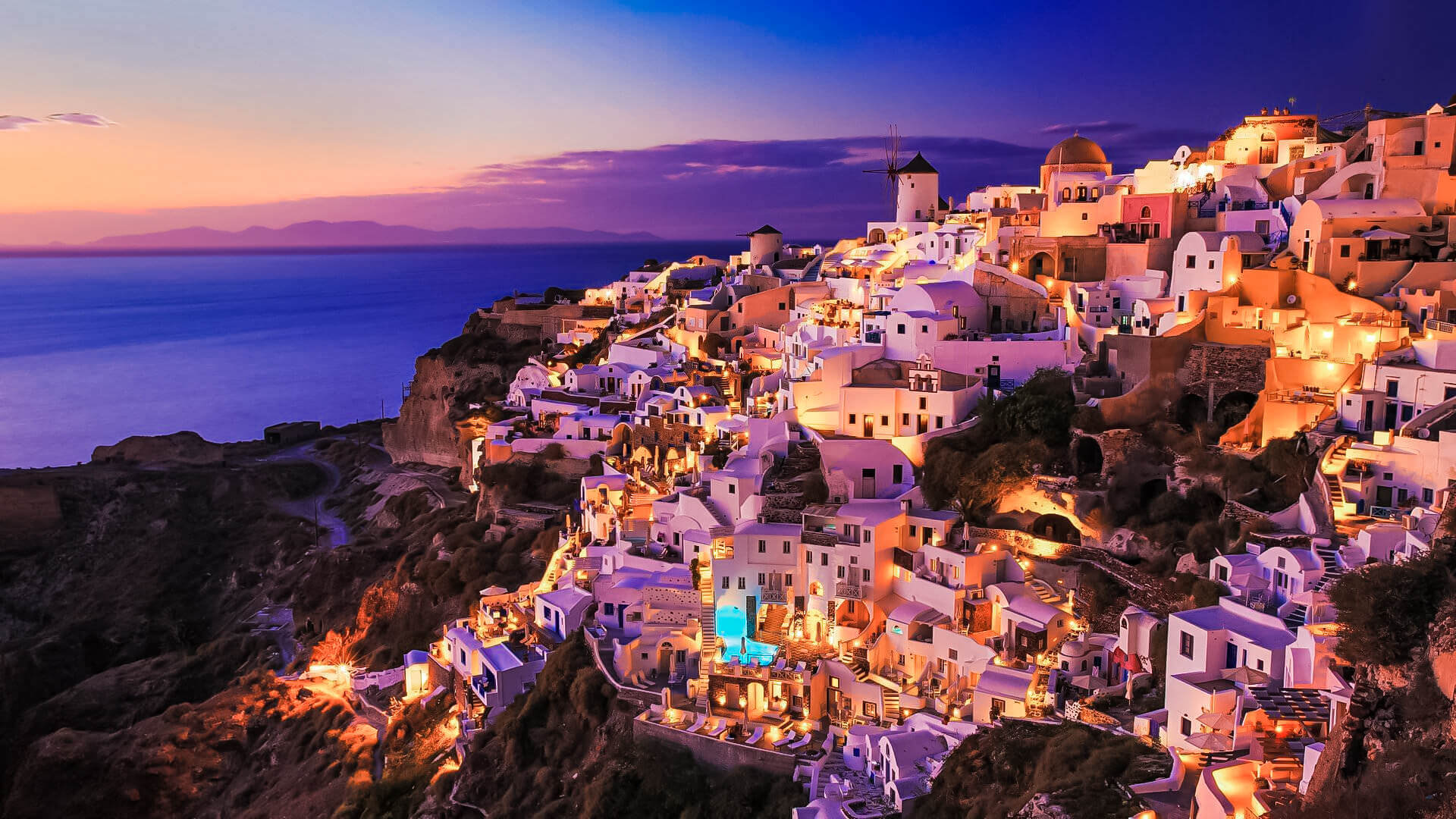Anyone wishing to consume alcohol in Greece would do well to stick to the traditional Greek national products mentioned below, which are freely available, usually cheap by European standards and generally of good quality. Any imported non-Greek alcoholic beverages are likely to be very expensive if genuine, and if cheap may well be “bomba”, a locally distilled alcohol with flavours that sometimes, especially in bars on the islands that appeal to young people, masquerades as whisky, gin etc. and can be very expensive. If you drink it, you will regret it. Drink in respectable establishments where you can see the barman mixing your drink.
Water
A glass of water is traditionally served with every drink you order; one glass for each drink, especially with any form of coffee. Sometimes you are even served a glass of water first and then asked what you would like to drink. Sometimes it is better to take a bottle and not just a glass. In tourist areas you may have to ask for a glass of water if you want one. If you don’t get water with a coffee, you have fallen into a tourist trap. Also, if you have not specifically asked for a bottle instead of a glass and someone tries to charge you, you should refuse.
In most places a tourist would visit, tap water is drinkable; if in doubt, ask at your hotel. But often, although drinkable, it doesn’t taste very good, especially on some small islands (because it is imported and heavily chlorinated), and many visitors, like many Greeks, prefer bottled water. By law, the price of water in shops must remain within acceptable limits, which makes it much cheaper than in Anglosphere countries. Half a litre of bottled water costs (May 2013) €0.50 if you buy it on the street and only €0.15 if you buy it in the supermarket.
Wines
To buy or drink alcohol in Greece, you must be 17 years old by law, and photo ID is rarely required, especially in places where food is sold (many independent fast-food outlets serve alcohol).
Greece, a former wine-growing country, offers a wide range of local wines, from indigenous and imported varieties, including fortified and even sparkling wines. Greek wines are generally not available on the international market, as production is relatively low, costs are quite high and little is left for export. However, in the last decade Greek wines have won many international awards and a new generation of wineries has emerged. Exports are also on the rise.
Wine (Krasi: κρασί / oenos: οίνος ) is the drink of choice for most Greeks.
Almost all tavernas offer “wine on tap”, mostly local, which is usually of good quality and at a good price (6 to 8 €/litre, but check before ordering if you are in a tourist area).
Euro American Express Travellers Cheques. If they do, also try the red Imiglyko (semi-sweet), even if sweet wine is not usually your preference, it is unlike anything you know.
Retsina is a “resinous wine” with a strong and distinct taste that takes some getting used to. The taste comes from pine resin, which used to be used as a sealant for wine bottles and flasks. The best known and cheapest is “Kourtaki Retsina”.
Bottled wines have become increasingly expensive; some that the beginner might want to try are the white wines of Santorini and the red wines of Naoussa and Drama. All the wines and alcoholic drinks are cheaper in the supermarkets, but you can’t drink them in a bar unless you keep them hidden in small bottles and use them very discreetly.
Beer
Even though beer (bira: μπύρα) is drunk all over the country, you don’t come to Greece for the beer. The only widely available local varieties are Mythos and Alpha, but Greeks mostly drink northern European beers made under licence in Greece, such as Heineken and Amstel. Heineken is affectionately called “green”; order it by saying “Mia Prasini”.
In terms of quality, there is also a microbrewery/restaurant called Craft (2-litre jugs are also available in large supermarkets) and new organic beer producers like Piraiki Zythopoiia.
Liqueur
The best-known local Greek liqueur is ouzo(ούζο), a strong alcohol (37.5%) with an aniseed flavour that is transparent by itself but turns milky white when mixed with water. Mainlanders do not drink ouzo with ice, but Greek tourists and islanders usually do. A 200 ml bottle can cost less than 2 euros in supermarkets and rarely more than 8 euros, even in the most expensive restaurants. Mytilene(Lesvos) is particularly famous for its ouzo. Try “Mini” and “Number 12”, two of the most popular, made in the medium style, “Sans Rival”, one of the strongest tasting of aniseed, “Arvanitis”, much lighter, and the strong “Barba Yianni” and “Aphrodite”, more expensive and much appreciated by connoisseurs.
Raki or tsikoudia is the Greek equivalent of Italian grappa and is made by boiling the grape residue after pressing the wine. It is quite strong (35-40% alcohol) and is served cold in the summer months. It costs very little to buy in supermarkets or village shops. The process of making raki has become a masculine event, as usually men get together to make raki and get drunk, constantly tasting the raki as it comes hot from the distillery. A working raki distillery can be seen at Ippikos Omilos Irakleiou in Heraklion, but raki can be found in most larger villages. In northern Greece it is also called tsipouro (τσίπουρο). In Crete, raki is traditionally considered an after-dinner drink and is often served with fruit for dessert.
Coffee
Coffee (kafes: καφές) is an important part of Greek culture.
The country is littered with kafeterias (kafetéria singular), which are cafés that serve as popular meeting places for Greeks, especially those under 35. They tend to be quite trendy – but relaxed – and serve a variety of drinks, from coffee to wine, beer and spirits to snacks, desserts and ice cream. In the pleasant spring, summer and autumn months, all cafeterias offer outdoor tables and seating and are popular with customers in the late afternoon and evening. Several cafés also serve as bars.
Kafeneia (cafés) are ubiquitous, even in the smallest village, where they traditionally serve a similar function to the village pub in Ireland. The clientele is mainly men over 50, but everyone is welcome, man or woman, young or old, Greek or foreign; and you will be treated with the utmost courtesy. However, if you are not interested in cultural immersion, you might find Kafeneia quite boring.
Traditionally, the coffee is made with the coffee grounds left on site. It is actually a slightly lighter version of Turkish coffee, but in Greece it is known only as Greek coffee – “ellinikós kafés” or simply “ellinikós“. Although it is slightly lighter than the original Turkish coffee, it is still a thick, strong black coffee served in a small cup, sweetened or unsweetened. If you don’t specify, the coffee is usually served moderately sweet. Traditionally, Greek coffee was prepared by boiling the coffee grounds and water in a special small pot called a “briki” over a fire. Nowadays, it is increasingly prepared by simply injecting steam from an espresso machine into the water-coffee mixture in the briki, resulting in an inferior drink. If you find a place that still prepares its coffee with a cooker burner, you can be sure that it is a traditional coffee.
In the hot summer months, one of the most popular coffees from the kafetéries is the frappé(φραπέ): a shaken instant iced coffee. It is indeed an original Greek coffee that can be very refreshing, ordered with or without milk, sweetened or unsweetened.
Coffee can also be prepared like an espresso, with the French press (mainly in hotels) and with modern filter technology. The latter is sometimes called Γαλλικός: gallikos (“French”), which can lead to some confusion with the press method. It is best to ask for φίλτρου: filtrou, which clearly refers to filter coffee. It is best not to ask for black coffee, as it is unlikely that anyone will understand what you are asking.
Freddo espresso or freddo cappuccino have gained popularity in the last decade and are the most popular coffees throughout Greece. Freddo espresso is simply espresso + ice; freddo cappuccino is espresso + ice + chilled milk foam. They can be served in foam containers, not made to order; be sure to check.
Ice tea
In pubs and cafés, iced tea is usually instant; ask twice if you prefer brewed iced tea.


